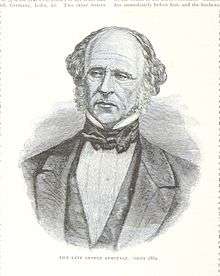George Armytage (grazier)

George Armytage (1795–1862) was a farmer and pastoralist, builder of The Hermitage in Geelong, Victoria (Australia).[1]
Armytage was born at Ticknall, Derbyshire, England in 1795, and was educated at schools in Yorkshire. He was the son of George Armytage (senior), who died in Australia in 1853, having emigrated at the age of eighty-seven. Armytage junior subsequently studied engineering in London until his twentieth year, when, on 28 February 1815, he sailed for Australia in the Hebe.[1]
Armytage reached Sydney in August 1815. In the following year he landed in Van Diemen's Land (now Tasmania), where he was allotted a few acres of land at Bagdad, which were increased to 500 acres in 1817. In 1826 he received a further grant of 1,000 acres (400 ha), built upon it the first watermill in Tasmania, and, in spite of troubles with Indigenous Australians and bushrangers, became successful. In 1835 Port Phillip District (later called Victoria) commenced to attract settlers; and in 1836 his eldest son Thomas visited the district, and camped on the Werribee River. In 1847 Mr. Armytage proceeded to Victoria, and settled upon his son George Armytage's station at Ingleby, where his eldest son had died of typhus fever on 12 September 1842. In 1851 he settled at Geelong, and built "The Hermitage." In 1818 he married Miss Elizabeth Peters. He died of erysipelas in 1862, his widow surviving him until 1873.[1]
References
- 1 2 3 Mennell, Philip (1892). "
 Armytage, George". The Dictionary of Australasian Biography. London: Hutchinson & Co. Wikisource
Armytage, George". The Dictionary of Australasian Biography. London: Hutchinson & Co. Wikisource
External links
- Armytage, George (1795–1862) Australian Dictionary of Biography